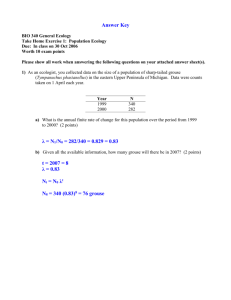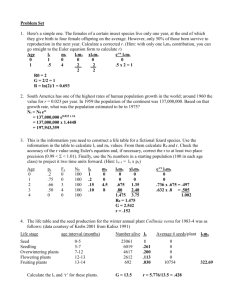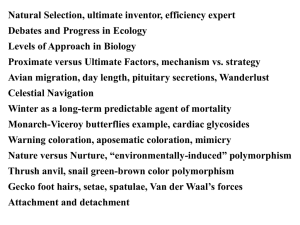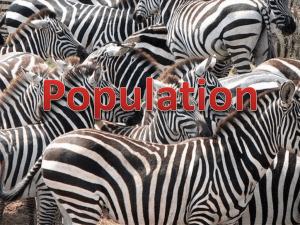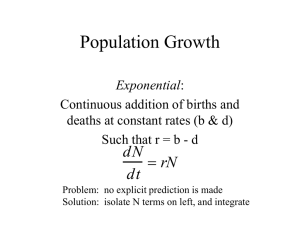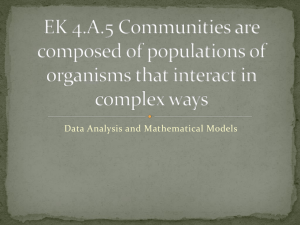lect 5_Populations and life tables
advertisement
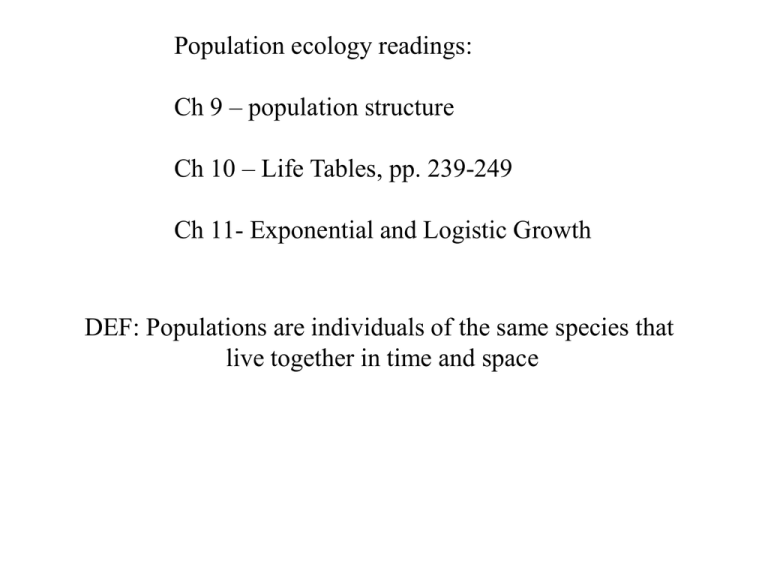
Population ecology readings: Ch 9 – population structure Ch 10 – Life Tables, pp. 239-249 Ch 11- Exponential and Logistic Growth DEF: Populations are individuals of the same species that live together in time and space POPULATION ECOLOGY Why here and why now? (1) Populations have emergent structures…. - Wolf packs; cooperative hunting, deferred reproduction individuals Are born and die Disperse populations birth rates and mortality rates immigration and emigration rates Extinction population structures (e.g., clumping) Evolve POPULATION ECOLOGY Why here and why now? (2) Many important processes related to, in particular, mortality and reproduction are Density Dependent as opposed to being Density Independent. Abiotic forces are density independent: Are these statements always true? - Fire kills irrespective of the number of trees - Saguaros: Frost kills irrespective of the number of cacti - Cold weather kills irrespective of the number of squirrels Biotic forces are density dependent: - Competition: your food availability depends on how many mouths there are - Predation: predators seek food patches containing many prey - Escaping predation depends on group defense - Mutualisms: seed production depends on the number of pollinators Hence, we want to characterize the number of individuals Populations: Abundance ( # individuals) Survival of indivs: Reproduction of indivs: } or Density (# individuals/area) Project abundance/density into the future Growth Rate Building Life Tables: (1) Follow a population (or given group of indivs – a cohort) from birth to death (2) Follow a population of known-age indivs for a shorter period of time and record deaths and births as a function of age Terms: X = Age (days, weeks, years) of individuals NX = Number of individuals alive at the start of age X lX = Proportion of the initial population that is alive at the BEGINNING of age X. ****l0 = 1.0 mX = The number of daughters born to an average female during the interval X to X+1. Because only females contribute to population growth, life tables only track female individuals Age # X 0 1 2 3 4 NX 100 50 25 12 0 survivor maternity lX 1.0 0.5 0.25 0.12 0 mX 0 1 3 2 0 What do we have? (1) Maximum lifespan is 4 years Age # survivor maternity X 0 1 2 3 4 NX 100 50 25 12 0 lX 1.0 0.5 0.25 0.12 0 mX 0 1 3 2 0 (2) We can plot the natural logarithm of NX (or lX) versus age to examine survivorship: (book plots Nx on a Log scale) Population experiences constant survivorship with age: ~ ½ the population dies at each interval ln(NX) age X This is in contrast with populations that senesce: E.g., Humans, whales ln(NX) age X or, experience greatest mortality early in life E.g., Most insects, many plants ln(NX) age X Age # X 0 1 2 3 4 NX 100 50 25 12 0 survivor maternity lX 1.0 0.5 0.25 0.12 0 mX 0 1 3 2 0 (3) Reproductive effort (per individual) is greatest at midlife But even better, we can calculate a population growth rate and determine whether the population is increasing or declining Age # X 0 1 2 3 4 NX 100 50 25 12 0 survivor maternity lX 1.0 0.5 0.25 0.12 0 mX 0 1 3 2 0 lXmX 0 0.5 0.75 0.24 0 lXmX = the number of daughters each initial female can expect to give birth to during the interval X to X+1. Age # X 0 1 2 3 4 NX 100 50 25 12 0 survivor maternity lX 1.0 0.5 0.25 0.12 0 mX 0 1 3 2 0 lXmX 0 0.5 0.75 0.24 0 The difference between lXmX and mX is the former accounts for mortality. E.g., m2 = 3 and L3m3 = 0.75. 0.75 < 3 because 75% of females die before the age of 2 lXmX 0 0.5 0.75 0.24 0 Expected # daughters between ages 0 – 1 Expected # daughters between ages 1 – 2 Expected # daughters between ages 2 – 3 Expected # daughters between ages 3 - 4 If we add all these up, we get the expected number of daughters over a females lifetime That sounds Useful !!! And IT IS The sum of lXmX is called the Net Reproductive Rate, R0 R0 = (lXmX) is the expected number of daughters born to each female during her lifetime. It is true that many females do not reproduce, those that do have many daughters in their lifetime – what we are examining is the reproductive output of the average female. Given that each female dies in her lifetime (-1 female) if R0 = 1 daughter, then she exactly replaces herself in her lifetime Has the population therefore grown or declined?? If R0 = 1 the population is neither growing or declining, rather population size is stable. If, however, R0 > 1 the population is growing And, if R0 < 1 the population is declining R0 = 1.25 = 25% population increase/generation ** R0 = 0.67 = 33% population decrease/generation ** ** True in special circumstances (e.g., annual plants) Why are Life Tables Useful?? We can tell at a glance: (1) patterns of survivorship, (2) at what age reproductive potential is “stored”, (3) The direction and magnitude of population change Furthermore, we can understand the effects of changes in age-specific death or maternity whether by accidental or by design. Peter and Rosemary Grant’s study of Darwin’s Finches Life Tables – the COHORT approach The STATIC approach Percentage of finches See Fig. 10.19 in your text 50 1983 Bottom-heavy Increasing populations drought 1977 25 0 1 2 3 4 5 6 7 8 9 10 11 50 1987 La Niña 25 0 Top-heavy declining populations droughts 1 2 3 4 5 6 7 8 9 10 11 Age in years X 0 1 2 3 4 5 6 NX 100 50 25 13 6 3 0 lX 1.0 0.5 0.25 0.13 0.06 0.03 0 mX Constant mortality 0 rate with age and 1.0 reproductive 3.0 senescence 1.0 0.5 0 0 R0 = 1.41 -------------------------------------------------------X 0 1 2 3 4 5 6 NX 100 50 10 5 3 1 0 lX 1.0 0.5 0.1 0.05 0.03 0.01 0 mX 0 1.0 3.0 1.0 0.5 0 0 R0 = 0.865 Hunters target young adults X 0 1 2 3 4 NX 100 50 25 13 0 lX 1.0 0.5 0.25 0.13 0 mX 0 1.0 3.0 1.0 0.5 R0 = 1.38 Hunters target old adults X 0 1 2 3 4 5 6 NX 100 20 10 5 2 1 0 lX 1.0 0.20 0.10 0.05 0.02 0.01 0 mX Constant mortality (50%) 0 rate with age and 0 increasing reproductive 2.5 2.5 output with age 3.0 3.0 0 R0 = 0.465 -------------------------------------------------------X 0 1 2 3 4 5 6 NX 100 40 20 10 5 2 0 lX 1.0 0.4 0.2 0.1 0.05 0.02 0 mX 0 0 2.5 2.5 3.0 3.0 0 R0 = 0.96 Increase survival of hatchlings X 0 1 2 3 4 5 6 NX 100 20 15 11 8 6 0 lX 1.0 0.20 0.15 0.11 0.08 0.06 0 mX 0 0 2.5 2.5 3.0 3.0 0 R0 = 1.07 Increase survival of adults The Niche concept place in a Population Framework Realized Niche R0 < 1.0 predation R0 > 1.0 competition Factor One Factor Two Fundamental Niche
